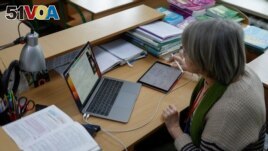24 March 2024
Editor's note: This story is one of the winning entries from the "Teach Us about Ukraine" writing contest sponsored by VOA Learning English and GoGlobal.
Ukrainian schools have been changing since 2017 with the adoption of new laws and standards. But other events also led to the changes in the Ukrainian education system.

FILE - Teacher conducts an online chemistry lesson in a classroom at a school, amid Russia's attack on Ukraine, in Kyiv, Ukraine, Dec. 2, 2022. ( REUTERS/Valentyn Ogirenko)
In September 2017, a new law, "Law on Education" was passed to establish the main principles of the new education system. And the cabinet of ministers, in February 2018, approved a new state standard of primary education.
The new standard was first tested in 100 schools across Ukraine during the 2017-2018 school year. And all first-graders around the country began to study under this new standard the following year.
Instead of memorizing facts and concepts, students are to acquire competencies and lifelong learning in several areas. More attention is paid to the "21st-century skills" of cooperation, communication, creativity, and critical thinking.
The reform, called "New Ukrainian School," had been discussed for years. However, some factors and events greatly influenced and brought the changes.
Another change to the Ukrainian education system came from the COVID-19 pandemic. Schools were closed during quarantine. Students did not go to school but started online learning. That, in turn, helped increase digital literacy. Teachers and students learned to use Zoom, Google Meet, Google Classroom and other digital applications. Teachers also learned to create video materials and develop interesting school work and exercises.
The emotional part of learning also changed. The friendly, warm atmosphere and the feeling of home and unity appeared in the lessons. The following lesson is an example:
"Would you, please, read, Mathew?," asks the teacher
"Can you show us your cat?," Mathew replies
"Well, we are going to do our tasks first, and we'll have five minutes at the end of the lesson to show our pets."
At the beginning of online learning, many students kept their cameras off during the lesson. Some were shy. Others did not like how they looked and did not want to show their faces. As time went on, students began to feel more comfortable and turned their cameras on. Besides, how can you show your cat without the camera?
The situation changed again in February 2022, with the Russian invasion. Cities and villages were attacked. Some were occupied. Others lost electricity and internet. And there was no learning for months. In September, online learning restarted with a different mood. Students would ask each other:
"Hello, Nick. How are you?"
"Fine."
"Is everything all right?"
"Yes."
But everyone understands that everything is not all right. They give short answers in a low voice. Students in the Russian-occupied territory are not permitted to study at Ukrainian schools. Their cameras are off. It is not because of shyness. It is because of fear. But the rest of the students turn off their cameras, too. It is done in solidarity. Even as teenagers, they are old enough to understand what danger means.
So, Ukrainian schools are now changing. The changes are not just in buildings, lessons, competencies or methods. The changes are in people's lives.
I'm Gena Bennett.
________________________________________________
About the Writer
The author is an English teacher in a currently Russian-occupied territory of Ukraine. This is a photo of her school, taken one month before the invasion.
What do you think of this story? Let us know in the Comments.